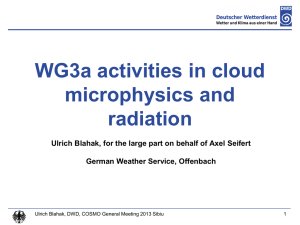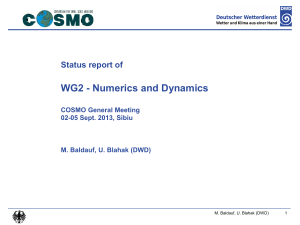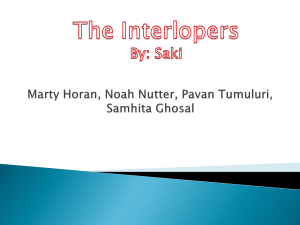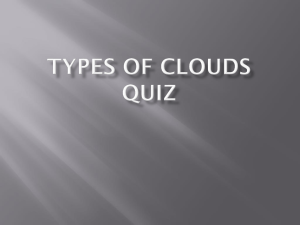Cloud ice
advertisement
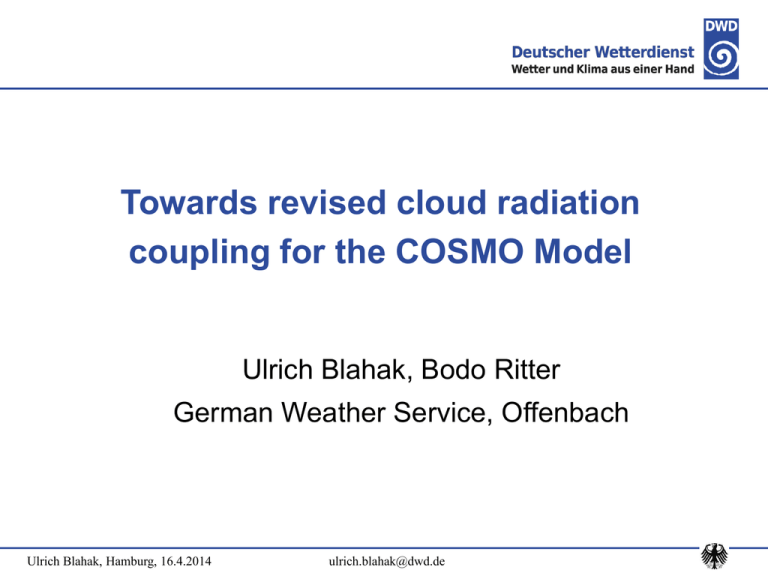
Towards revised cloud radiation coupling for the COSMO Model Ulrich Blahak, Bodo Ritter German Weather Service, Offenbach Ulrich Blahak, Hamburg, 16.4.2014 ulrich.blahak@dwd.de Outline COSMO-model and it‘s current radiation and cloud schemes Recent developments towards more consistent coupling Open questions Ulrich Blahak, Hamburg, 16.4.2014 ulrich.blahak@dwd.de The COSMO-Model Non-hydrostatic, compressible limited area model for numerical weather prediction, regional climate simulations (COSMO-CLM) and fully online coupled aerosol / reactive trace gases chemical dispersion model (COSMOART) Worldwide and „broadband“ user community: COSMO-Consortium: 7 European NWS Diverse research at universities (real cases / idealized) CLM-Community: > 50 member institutions, > 200 members COSMO-ART: used by research institutes, but also for operational pollen, mineral dust and volcanic ash forecasts Operational at ~ 30 NWS worldwide Ulrich Blahak, Hamburg, 16.4.2014 ulrich.blahak@dwd.de Numerical weather prediction at DWD in 2013 COSMO-EU Grid spacing: 7 km Layers: 40 Global model GME Forecast range: Grid spacing: 20 km 78 h at 00 and 12 UTC Layers: 60 48 h at 06 and 18 UTC Forecast range: 1 grid element: 49 km2 174 h at 00 and 12 UTC COSMO-DE (-EPS) 48 h at 06 and 18 UTC 1 grid element: 346 km2 Grid spacing: 2.8 km Layers: 50 Forecast range: 21 h at 00, 03, 06, 09, 12, 15, 18, 21 UTC 1 grid element: 8 km2 Ulrich Blahak, Hamburg, 16.4.2014 ulrich.blahak@dwd.de COSMO radiation scheme Ritter and Geleyn (1992) Delta-two-stream approximation 8 spectral bands only (3 visible, 5 infrared) Includes aerosol scattering (climatology or COSMO-ART) Clouds: grid scale (QC and QI), subgrid scale, convective For the gridscale clouds, only a fraction k=0.5 of qi and/or qc is considered in the radiation scheme („tentative“ effective factor to take into account subgrid scale variability). Optical properties of hydrometeors are pure fct(qx) derived for „typical clouds“ Operationally called only every 1 h (COSMO 7km) resp. 15 min (2.8 km) Ulrich Blahak, Hamburg, 16.4.2014 ulrich.blahak@dwd.de COSMO cloud microphysics Fully prognostic conventional 1-moment bulk schemes Cloud drops: Gamma distribution for autoconversion Cloud ice: monodisperse, Ni = fct(T) similar to Cooper (1986) Rain: Gamma distribution (μ=0 reduces to Marshall-Palmer) Snow: Exponential PSD, N0 = fct(T) Graupel: Exponential PSD, fixed N0 Seifert-Beheng 2-moment bulk scheme Additional hail class All species are full 2-moment All PSDs assumed generalized Gamma Upcoming revisions of the 1-moment scheme: ice sedimentation, two-moment ice, improved ice nucleation, improved supercooled liquid in mixed-phase clouds, improved melting of snow Side note: 2-moment scheme can be fully coupled to COSMO-ART aerosols (a 2moment 5-class bulk aerosol formulation) Ulrich Blahak, Hamburg, 16.4.2014 ulrich.blahak@dwd.de COSMO subgrid scale clouds CLC = fct(QC, QI, generalized RHg, convective CLC) RHg: blending in mixed-phase region between water and ice saturation, using diagnosed ice fraction fice = fct(T); includes grid scale QC and QI, if present (Deardorff) CLC = 1 for gridscale clouds (QC and/or QI > 0) Otherwise weighted average between SGS CLC and convective CLC Water content of SGS water clouds = 0.005 * (RHsat,g - 1) * (1 – fice) Water content of SGS ice clouds = 0.005 * (RHsat,g - 1) * fice Water content of convective clouds = 0.02 * (RHg – 1) Ulrich Blahak, Hamburg, 16.4.2014 ulrich.blahak@dwd.de Motivation for changes Ulrich Blahak, Hamburg, 16.4.2014 ulrich.blahak@dwd.de Motivation for changes Ulrich Blahak, Hamburg, 16.4.2014 ulrich.blahak@dwd.de Some issues in cloud-radiation coupling In the COSMO radiation scheme (Ritter & Geleyn 1992), the optical properties (extinction coeff., single scattering albedo, asymmetry factor) only depend on qc respectively qi. Nowadays more modern parameterizations based on an effective radius Re are available. From inherent assumptions about N(D) and particle shapes in state-of-theart microphysical models Re can be deduced. Then: optical properties = fct (qx, Re) Inhomogeneity factor 0.5 still appropriate for today‘s models? There are also other hydrometeors than QC and QI! ρc Ulrich Blahak, Hamburg, 16.4.2014 ulrich.blahak@dwd.de Revised optical properties βext, ω, g = fct(Re,qx,λ) Re for grid scale clouds derived from cloud microphysics (1-mom, 2-mom) For cloud droplets: Parameterisation of Hu and Stamnes (1993), spectrally remapped to the 8 spectral intervals of RG92. For cloud ice: Visible spectral region: optionally Key et al. (2002), assuming horizontally aligned hexagonal plates or Fu et al. (1998), assuming randomly oriented hexagonal needles Infrared region: Fu et al. (1996), assuming randomly oriented hexagonal needles Important: Definition of Re is different for different authors and different spatial orientation! Ulrich Blahak, Hamburg, 16.4.2014 ulrich.blahak@dwd.de Recalling scattering parameters For a certain wavelength: (First moment of the scattering function) Ulrich Blahak, Hamburg, 16.4.2014 ulrich.blahak@dwd.de Parameterizations from literature Either give β‘ext (= βext/LWC) , ω , g as regression functions of (Re,λ) directly for many wavelengths λ, or averaged over more or less „narrow“ wavelength bands. In any case, necessary to average/aggregate them onto the RG92 wavelength bands: ( Further averaging of β‘ext over: „typical“ range of model dz and certain PDF of gridscale ρc ) Ulrich Blahak, Hamburg, 16.4.2014 ulrich.blahak@dwd.de Definition of Re for droplets Motivated by: Specific Ext. Factor: Therefore: Ulrich Blahak, Hamburg, 16.4.2014 ulrich.blahak@dwd.de Cloud droplets based on Hu and Stamnes (1993): RG92 wavelength interval no. 4 (infrared) Ulrich Blahak, Hamburg, 16.4.2014 ulrich.blahak@dwd.de Cloud droplets based on Hu and Stamnes (1993): RG92 wavelength interval no. 4 (infrared) Ulrich Blahak, Hamburg, 16.4.2014 ulrich.blahak@dwd.de Cloud droplets based on Hu and Stamnes (1993): RG92 wavelength interval no. 2 (central visible) Ulrich Blahak, Hamburg, 16.4.2014 ulrich.blahak@dwd.de Cloud droplets based on Hu and Stamnes (1993): RG92 wavelength interval no. 2 (central visible) Ulrich Blahak, Hamburg, 16.4.2014 ulrich.blahak@dwd.de Cloud droplets comparison to RG92 If grid scale qc > 0: from cloud microphysics: Spectral interval „2“ (visible range) βext ratio HS / RG92 Ulrich Blahak, Hamburg, 16.4.2014 ulrich.blahak@dwd.de Cloud droplets comparison to RG92 If grid scale qc > 0: from cloud microphysics: Spectral interval „5“ (infrared range) βext ratio HS / RG92 Ulrich Blahak, Hamburg, 16.4.2014 ulrich.blahak@dwd.de Sugrid scale water clouds Pure subgrid scale clouds ??? → Re = 10 μm (or 5? or 15? TUNING) Real case studies by Anna Possner (ETHZ) and a Master student for some fog cases in Switzerland and comparing 1-moment and 2-moment microphysics, indicates that for these cases a smaller value should be used, e.g., 5 μm, but that might depend on the case. There are explicit relations of Re = fct(LWC) in literature, derived from measurements for certain cloud types and regions in the world. (see next slides for an example, but not implemented yet!) SGS cloud water content = P1 * (RHsat,g - 1) * (1 – fice) P1 is now a tuning parameter, replacing the formerly constant 0.005 „Coarser grid“ radiation calculations??? → The definition of Re suggests spatial averaging of 1/Re , weighted by ρc Ulrich Blahak, Hamburg, 16.4.2014 ulrich.blahak@dwd.de Subgrid scale water clouds Just an example on measurements of Re in water clouds, that are subscale to our models. There are more papers on field experiments out there! Something like that could replace the currently constant assumption for Re in subgrid scale water clouds in the model! Ulrich Blahak, Hamburg, 16.4.2014 ulrich.blahak@dwd.de Definition of Re for ice particles Depends on particle spatial orientation assumption and might be different for different parameterizations! Fu et al. (1996, 1998) assume randomly oriented hexagonal columns. If L = length and D = width of the needles, x = aLb (mass-size-relation from the cloud microphysics scheme) and the particle shape determine D(L). Then, using the PSD shape assumption N(L) from microphysics: Ulrich Blahak, Hamburg, 16.4.2014 ulrich.blahak@dwd.de Cloud ice based on Fu et al. (1996): RG92 wavelength interval no. 4 (near infrared) Validity range! Ulrich Blahak, Hamburg, 16.4.2014 ulrich.blahak@dwd.de Cloud ice based on Fu et al. (1998): RG92 wavelength interval no. 2 (central visible) Validity range! Ulrich Blahak, Hamburg, 16.4.2014 ulrich.blahak@dwd.de Cloud ice (visible; Fu et al.) If grid scale qi > 0: from cloud microphysics: Spectral interval „2“ (visible range) βext ratio Fu / RG92 Ulrich Blahak, Hamburg, 16.4.2014 ulrich.blahak@dwd.de Cloud ice (infrared; Fu et al.) If grid scale qi > 0: from cloud microphysics: Spectral interval „5“ (infrared range) βext ratio Fu / RG92 Ulrich Blahak, Hamburg, 16.4.2014 ulrich.blahak@dwd.de Subgrid scale ice clouds SGS ice content:= P2 * (RHsat,g - 1) * fice P2 is now a tuning parameter, replacing the formerly constant 0.005 ni = fct(T) from COSMO microphysics from this and SGS ice content and assumption about PSD, compute Re Scattering parameters from Re and SCS ice content Ulrich Blahak, Hamburg, 16.4.2014 ulrich.blahak@dwd.de Include grid scale qs, qg and qr into radiative calculations Comutation of Re the same as for QC resp. QI. For QS and QG the mass-size relations for snow and graupel are used, not the ones for cloud ice. But still we assume simple hexagonal shapes for the particles. However, parameterizations of βext , ω and g only valid for r <~ 70 μm, therefore largesize-approximation for larger Re Large-size approximation for βext : Based on βext → 2 for πD/λ >> 1 and spherical particles For rain: constrain the fits so that they are asympotically correct For snow and graupel: recompute Re,LS and blend into QI fits, based on 2πRe/λRG92 : Large-size approximation for ω and g: constant extrapolation towards larger sizes Ulrich Blahak, Hamburg, 16.4.2014 ulrich.blahak@dwd.de Large size approximation Beta_ext for rain: Ulrich Blahak, Hamburg, 16.4.2014 ulrich.blahak@dwd.de Large size approximation Beta_ext for snow / graupel: Blending of βext,Fu (Re) → βext,LS (ReLS) Ulrich Blahak, Hamburg, 16.4.2014 ulrich.blahak@dwd.de Resulting scattering parameters Snow β Rain Blending Large-size approx. σ Range of fits from literature g (spectral band no. 5) Ulrich Blahak, Hamburg, 16.4.2014 ulrich.blahak@dwd.de Constant extrapolation of ω and g Justification: very recent paper on single particle scattering parameters up to 20 mm diameter! (JAS, 2013) Ulrich Blahak, Hamburg, 16.4.2014 ulrich.blahak@dwd.de Some model specific tuning Cloud drops: Re based on nc = nc0 * „exponential decrease with height“ nc0 = new tuning parameter (representing aerosol conditions) Cloud ice: Re based on ni = fct(T) from microphysics scheme Snow: Re based on PSD intercept parameter N0s = fct(T) from microphysics scheme Model seems to produce sometimes very high column integrated values of TQC, TQI and TQS, and „the light wents out“ below such clouds. Therefore a clipping of QC, QI and QS is applied so that TQC, TQI and TQS do not exceed some threshold (3 new tuning parameters). Currently under closer investigation using Lindenberg Obs data, but not conclusive yet. Ulrich Blahak, Hamburg, 16.4.2014 ulrich.blahak@dwd.de Subgridscale variability, factor k cloudy grid box ρc PDF f(ρc) ρc 0 For higher resolution, k = 0.5 seems too low! Ulrich Blahak, Hamburg, 16.4.2014 ulrich.blahak@dwd.de ρcmin ρcmax Case study: 1.6.2013 (C-DE) COSMO-DE: cloud ice snow factor 10! Ulrich Blahak, Hamburg, 16.4.2014 ulrich.blahak@dwd.de Case study: 1.6.2013 (C-DE) Ulrich Blahak, Hamburg, 16.4.2014 ulrich.blahak@dwd.de Case study: 1.6.2013 (C-DE) Comparison of shortwave downward fluxes at the ground with CMSAF satellite product Ulrich Blahak, Hamburg, 16.4.2014 ulrich.blahak@dwd.de Case study: 1.6.2013 (C-DE) Old scheme After Tuning Ulrich Blahak, Hamburg, 16.4.2014 ulrich.blahak@dwd.de After „optimal“ tuning of the various new tuning parameters to minimize some composite error measure Case study: 1.6.2013 (C-DE) closer look at sensitivities Control + qs, qr, qg, nc0 = 200e6, Re for SGS water clouds = 5 μm, new Tegen aerosols + incr. k to 0.75 + decr. nc0 to 50e6 + incr. Re for SGS water clouds to 20 μm + incr. nc0 to 200e6 again Ulrich Blahak, Hamburg, 16.4.2014 ulrich.blahak@dwd.de Case study: 1.6.2013 (C-DE) Control „optimal tuning“ at k=0.9 + doubling LWC and IWC of SGS clouds + halfing LWC and IWC of SGS clouds + halfing nc0 + halfing nc0 and doubling Re of SGS water clouds 2-moment scheme Ulrich Blahak, Hamburg, 16.4.2014 ulrich.blahak@dwd.de Summary of the method Implemented Re based parameterizations of the optical properties of cloud droplets and cloud ice from literature Extrapolation of these parameterizations for the larger Re of snow, graupel and rain with the help of a large size approximation Nc0 of cloud droplets is new tuning parameter Subgrid variability factor k for grid scale clouds investigated. Previous value 0.5 too low. Treated as new tuning parameter. Uncertain properties of SGS clouds are treated as tuning parameters Some other minor new tuning parameters Next step has to be a considerable reduction of tuning parameters! Ulrich Blahak, Hamburg, 16.4.2014 ulrich.blahak@dwd.de Conclusions Changes in cloud radiation coupling can lead to big changes of T_2M and possibly other model variables. This gives us a pretty big handle on the model! Sensitivities: The implemented Re-parameterisations make the ice clouds optically thinner in the visible and infrared, therefore increased shortwave heating and longwave cooling in the presence of clouds. Including qs/qg and increasing factor k both counteract this, the clouds get optically thicker at all wavelengths, so Tmax during day is reduced. However, entire model currently tuned to the previous method of cloud radiation coupling (SGS cloud diagnostics, ...). Therefore, to uncover possible beneficial effects of the presented new method requires extensive re-tuning of the model! We are in the middle of this process, but will perhaps take a long time! Changes in the cloud microphysics scheme now also have a more direct influence on the radiation! Ulrich Blahak, Hamburg, 16.4.2014 ulrich.blahak@dwd.de Scattering databases for snow/ice hydrometeors Key et al., 2002: shortwave radiation, different habits, but only up to Reff = 0.085 mm! Ulrich Blahak, Hamburg, 16.4.2014 ulrich.blahak@dwd.de Gridded T_2M from synop station data (COSMO-DE) Voronoi-interpolation, based on triangulation. Height correction to model surface height using standard atmosphere gradient. „Distance filter“: Max. distance from the next synop station 70 km. Synop data on the model grid, suitable for computing, e.g., bias and rms. Ulrich Blahak, Hamburg, 16.4.2014 ulrich.blahak@dwd.de Gridded T_2M from synop station data (COSMO-EU) Voronoi-interpolation, based on triangulation. Height correction to model surface height using standard atmosphere gradient. „Distance filter“: Max. distance from the next synop station 70 km. Synop data on the model grid, suitable for computing, e.g., bias and rms. Ulrich Blahak, Hamburg, 16.4.2014 ulrich.blahak@dwd.de
